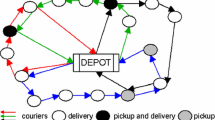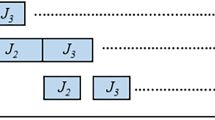Abstract
We combine mixed integer linear programming (MILP) and constraint programming (CP) to solve planning and scheduling problems. Tasks are allocated to facilities using MILP and scheduled using CP, and the two are linked via logic-based Benders decomposition. Tasks assigned to a facility may run in parallel subject to resource constraints (cumulative scheduling). We solve minimum cost problems, as well as minimum makespan problems in which all tasks have the same release date and deadline. We obtain computational speedups of several orders of magnitude relative to the state of the art in both MILP and CP.
Similar content being viewed by others
References
Baptiste, P., Le Pape, C., & Nuijten, W. (2001). Constraint-based Scheduling: Applying Constraint Programming to Scheduling Problems. Kluwer, Boston, MA.
Benders, J. F. (1962). Partitioning procedures for solving mixed-variables programming problems. Numer. Math. 4: 238–252.
Cambazard, H., Hladik, P.-E., Déplanche, A.-M., Jussien, N., & Trinquet, Y. (2004). Decomposition and learning for a hard real time task allocation algorithm. In Wallace, M., ed., Principles and Practice of Constraint Programming (CP 2004), Lect. Notes Comput. Sci. 3258. Springer, Berlin.
de Siqueira N, J. L., & Puget, J.-F. (1988). In Explanation-Based Generalisation of Failures, European Conference on Artificial Intelligence (ECAI-88), pages 339–344. Pitman Publishers, Munich.
Eremin, A., & Wallace, M. (2001). Hybrid Benders decomposition algorithms in constraint logic programming. In Walsh, T., ed., Principles and Practice of Constraint Programming (CP 2001), Lect. Notes Comput. Sci., 2239, pages 318–325. Springer, Berlin.
Geoffrion, A. M. (1972). Generalized Benders decomposition. J. Optim. Theory Appl. 237–260.
Hooker, J. N. (2000). Logic-Based Methods for Optimization: Combining Optimization and Constraint Satisfaction. John Wiley & Sons, New York.
Hooker, J. N. (2004). A hybrid method for planning and scheduling. In Wallace, M., ed., Principles and Practice of Constraint Programming (CP 2004), Lect. Notes Comput. Sci. 3258. Springer, Berlin.
Hooker, J. N., & Ottosson, G. (2003). Logic-based Benders decomposition. Math. Program. 96: 33–60.
Hooker, J. N., & Yan, H. (1995). Logic circuit verification by Benders decomposition. In Saraswat, V., & Van Hentenryck, P., eds., Principles and Practice of Constraint Programming: The Newport Papers, MIT Press, Cambridge, MA. pages 267–288.
Jain, V., & Grossmann, I. E. (2001). Algorithms for hybrid MILP/CP models for a class of optimization problems. INFORMS J. Comput. 13: 258–276.
Junker, U. (2001). Quickxplain: Conflict detection for arbitrary constraint propagation algorithms. In IJCAI01 Workshop on Modeling and Solving Problems with Constraints (CONS-1), Seattle.
Jussien, N. (2003). The Versatility of Using Explanations Withing Constraint Programming, Research Report 03–04-INFO. École des Mines de Nantes, France.
Jussien, N., & Ouis, S. (2001). User-friendly explanations for constraint programming. In ICLP'01 11th Workshop on Logic Programming Environments (WLPE'01). Paphos, Cyprus.
Ouis, S., Jussien, N., & Boizumault, P. (2003). K-relevant explanations for constraint programming. In Sixteenth International Florida Artificial Intelligence Research Society Conference (FLAIRS 03). AAAI Press, Menlo Park, CA, pages 318—325.
Sqalli, M. H., & Freuder, E. C. (1996). Inference-based constraint satisfaction supports explanation. In National Conference on Artificial Intelligence (AAAI 96).
Thorsteinsson, E. S. (2001). Branch-and-Check: A hybrid framework integrating mixed integer programming and constraint logic programming. In Walsh, T., ed., Principles and Practice of Constraint Programming (CP 2001), Lecture Notes in Computer Science 2239, pages 16–30. Springer.
Türkay, M., & Grossmann, I. E. (1996). Logic-based MINLP algorithms for the optimal synthesis of process networks. Comput. Chem. Eng. 20: 959–978.
Author information
Authors and Affiliations
Corresponding author
Rights and permissions
About this article
Cite this article
Hooker, J.N. A Hybrid Method for the Planning and Scheduling. Constraints 10, 385–401 (2005). https://doi.org/10.1007/s10601-005-2812-2
Issue Date:
DOI: https://doi.org/10.1007/s10601-005-2812-2




